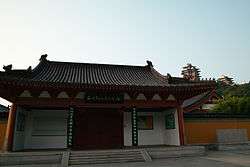Jinghai Temple
| Jinghai Temple | |
|---|---|
|
A picture of Jinghaisi Museum | |
| Basic information | |
| Geographic coordinates | 32°05′39″N 118°44′28″E / 32.09417°N 118.74111°ECoordinates: 32°05′39″N 118°44′28″E / 32.09417°N 118.74111°E |
| Affiliation | Buddhism |
| Country | China |
| Architectural description | |
| Completed | 1842 |
Jinghai Temple (Chinese: 静海寺; pinyin: Jìnghǎi Sì) is a 15th-century temple located in Nanjing, Jiangsu, China. It is located in the southwest of Shizi Mountain (Chinese: 狮子山).[1] It was built to commemorate the voyage of Zheng He by the emperor in Ming Dynasty.[2] In 1842, the terms of the Treaty of Nanking, China's first unequal treaty, were discussed in the temple. As a location where foreign diplomacy was carried out, the Jinghai temple holds special historical significance. The Jinghai temple was destroyed and rebuilt thrice, including during the Taiping Rebellion and the Second Sino-Japanese War.
In 1988, the People's Government of Nanjing rebuilt the temple at its original site. In 1990, the temple was repurposed as the Historical Exhibition Museum of the Treaty of Nanking. After two expansions in 1996 and 2005, Jinghai Temple is now the Nanjing Jinghai Temple Memorial, in which materials related to both Zheng He's Voyage and the Treaty of Nanking are exhibited. The Jinghai Temple is a National 4A Level Scenic Spot, as well as part of the National Patriotism Education Base, and the Nanjing Relic Protection Unit.
Overall introduction
Jinghai Temple (Temple of the Calm Sea) was built in 1416 by the Yongle Emperor of the Ming dynasty to honor Zheng He, a court eunuch, explorer and envoy who had traveled to India and even sailed as far as the east coast of Africa several times. The temple was originally built as a dedication to the Goddess of the Sea, Tianfei, who was named by the Emperor after a young woman from the Fujian province miraculously rescued sailors whose boats had gone adrift on the high seas.
It was one of Nanjing's largest and most lavishly decorated temples. It had witnessed the defeat of the Qing dynasty in the First Opium War (1839–1842), on August 29, 1842. The British ship, Cornwallis, anchored on the Yangtze River which is just west of Jinghai Temple. This was where the first Treaty of Nanking was signed. By the time of the Republican Period, after the Taiping Rebellion and the destruction of traditional architecture during the Cultural Revolution, the temple had almost disappeared. A reconstruction of Jinghai Temple was in process in 1987 and an extension was built in 1996, when it became the museum of the Nanking Treaty. Before the return of Hong Kong to mainland China in 1997, this museum became the site for nationalist celebrations. Today the museum occupies only 15% of the Jinghai Temple. The only remaining part of the original temple is a stele which was established and written by the Yongle emperor himself.
In addition, the museum was built next to a large outcropping rock known as Sansuyan (Three Night Crag) where the Southern Song general Yu Yunwen moored his fleet for three nights on his return trip after defeating the Jin army in Anhui province.[3]
History
Jinghai Temple was built in the Ming Dynasty to praise Zheng He's voyages. Meanwhile, it is also a place where offers the Arhat portraits which is one element if Buddha, teeth relic of the Buddha and jade wares, etc. Jinghai literally means "peace and ocean" in Chinese, which indicates blessings for the people who are on voyage and gradually develops as a universal peace later on. It had been rebuilt and fixed for three times in different periods of Chinese history.
In June 1840, Great Britain declared a war, which was known as the First Opium War, and antagonized China. In 1842, British troops invaded Nanjing. The Qing government had discussed the unequal treaty with the British government for four times in Jinghai Temple. On August 29, the Qing government signed the Nanjing Treaty, which is the first unequal treaty in modern Chinese history, on a British navy ship. Therefore, Jinghai Temple became the symbol of the beginning of Chinese modern history.
During the past five centuries, Jinghai Temple has undergone disasters and warfare. In 1987, it was rebuilt with 628 square meters in the style of Ming dynasty. Since it could not be the same as the original one, Jinghai Temple was called Old Jinghai Temple Site. In 1990, the Nanjing government decided to make it as the public places, Nanjing Treaty Historical Exhibition Museum, in order to remains Chinese people for not forget the history. At the end of 1996, to celebrate Hong Kong’s return, the local government invested significant amount of money to fix and rebuild it. The Jinghai Temple was expanded to 2800 square meters in total. The structure of it is simple but elegant, similar to the Jiangnan garden style. In 1997, Jinghai Temple was honored as one of 100 National Patriotism Education Bases.
References
- ↑ "Jinghai Temple, Nanjing, China". Orientalarchitecture.com. Retrieved 2011-10-08.
- ↑ "静海寺", accessed in November 2011.
- ↑ "Jinghai Temple, Nanjing, China". Asian Historical Architecture. Asian Historical Architecture. Retrieved 22 March 2013.
External links
| Wikimedia Commons has media related to Jinghai Temple. |


